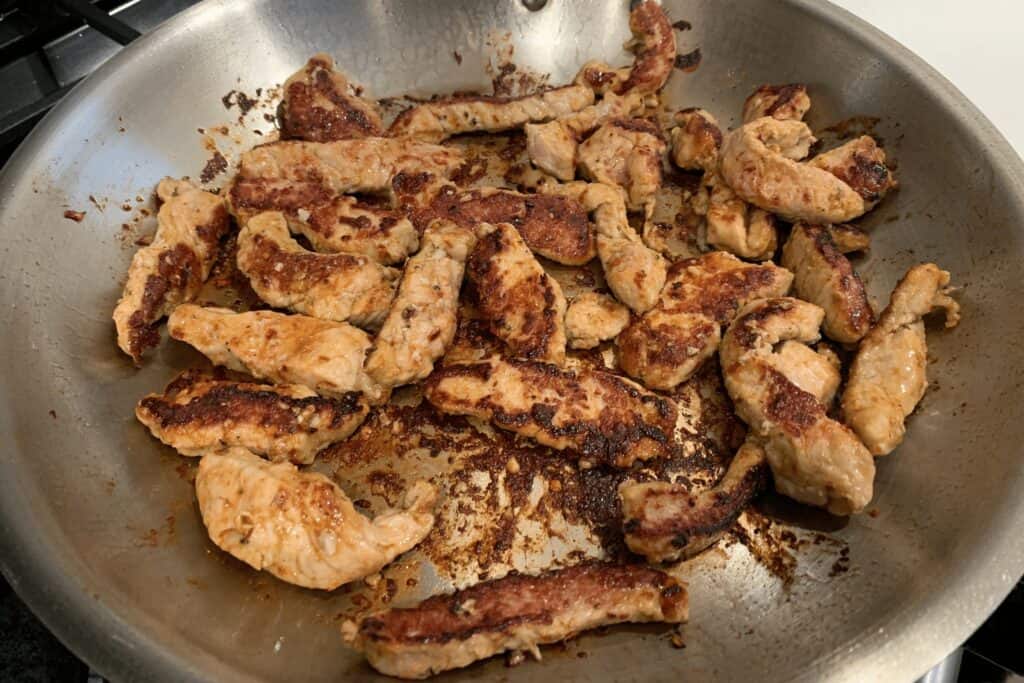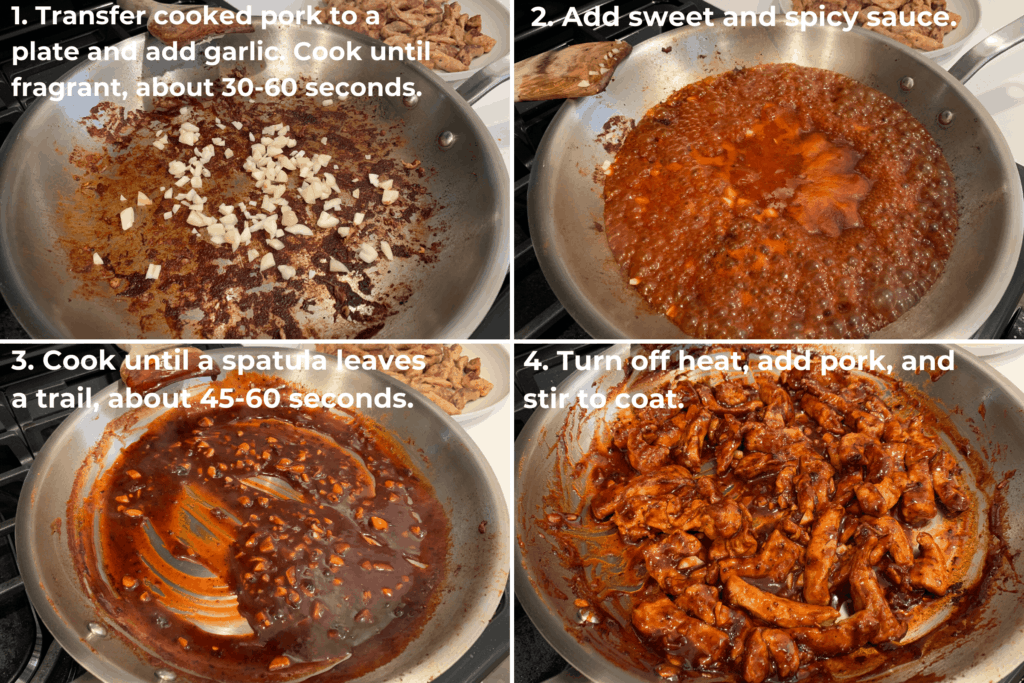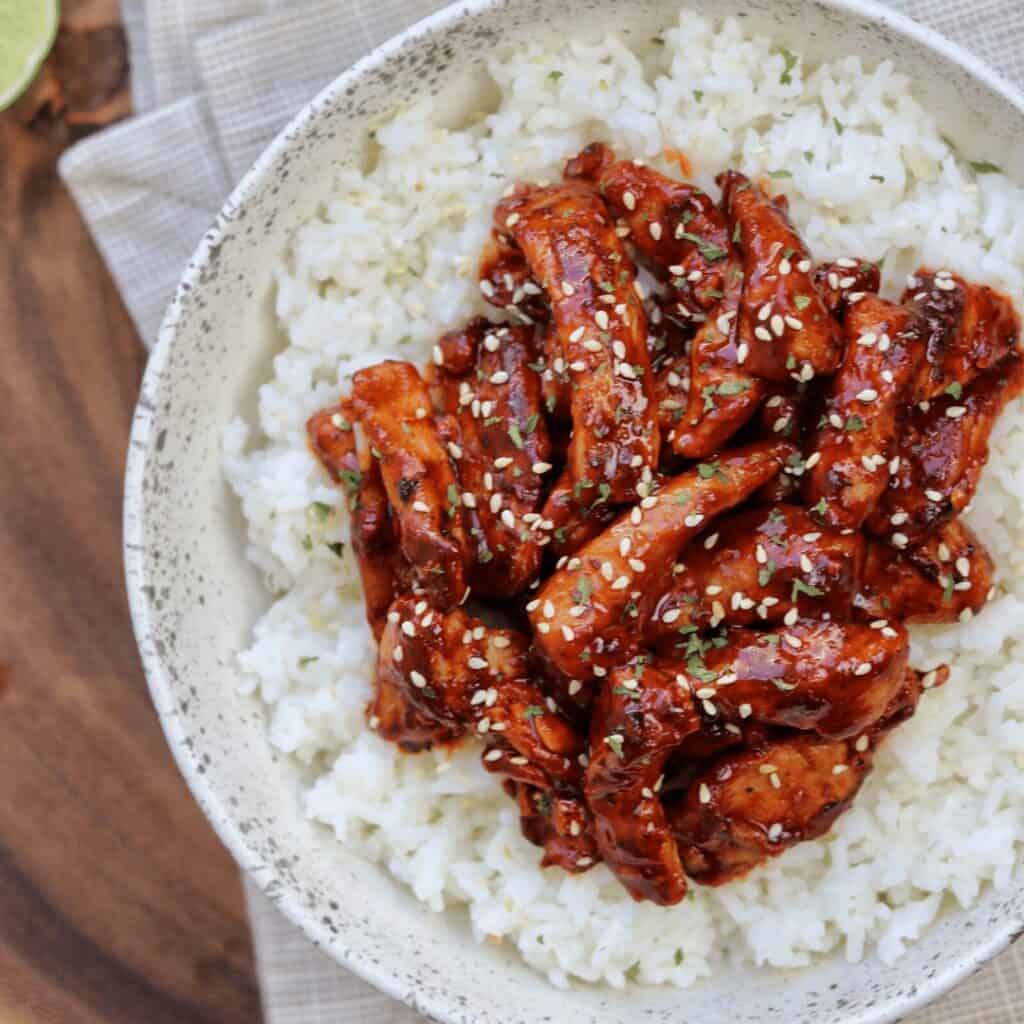For a change of pace, try this recipe instead of cooking pork tenderloin whole in the oven, pressure cooker, or crockpot. While the other methods require less work ahead of time, this sweet and spicy pork is much faster (and maybe even easier) than my other recipes, such as my crispy pork tenderloin carnitas or Traeger smoked pork tenderloin.
I’ll walk you through the recipe below and touch on ingredient substitutions as we go. There’s a printable recipe card at the bottom of the post. Have a question about a recipe? Read the post and leave a comment if I didn’t answer it already.
This recipe was inspired by Foodie with Family’s garlic ginger glazed sticky pork. You might as well try both recipes while you’re at it!.
This post may contain affiliate links. As an Amazon Associate, I earn from qualified sales. Click here to read my full disclosure.
Pork tenderloin is a lean tender cut of meat that can be transformed into delicious strips for stir-fries, fajitas kabobs, and more. With the right technique, cutting pork tenderloin into strips is easy. This guide will walk you through the entire process step-by-step.
Why Cut Pork Tenderloin into Strips?
Cutting the tenderloin into thin strips offers several advantages:
-
Strips cook faster than a whole tenderloin, making it perfect for quick weekday meals.
-
The strips soak up marinades and spice rubs extremely well, adding tons of flavor.
-
Strips offer more surface area for delicious browning when cooked.
-
Strips are easy to eat and serve, especially in dishes like stir fries or fajitas.
-
You can get just the right amount of pork by cutting it to the size you want.
Overall, strips are very flexible and simple to cook, and they keep the tenderness of pork tenderloin.
What You’ll Need
To properly cut pork tenderloin into strips. you’ll need
- 1 pork tenderloin, about 1 lb
- Sharp chef’s knife or carving knife
- Cutting board
- Paper towels
Optional but helpful tools include:
- Meat mallet or rolling pin
- Freezer (to firm up tenderloin before cutting)
Step 1: Prepare the Tenderloin
Start with a 1 lb pork tenderloin, trimmed of excess fat and silverskin membrane. Pat dry thoroughly with paper towels and place on a clean cutting board.
If the tenderloin is oddly shaped or curved, use a meat mallet or rolling pin to gently pound and flatten the tenderloin into an even thickness. This helps it cook evenly.
For easier slicing, place the tenderloin in the freezer for 30-60 minutes until very firm but not fully frozen.
Step 2: Cut Crosswise into Medallions
Using a very sharp chef’s knife, slice the tenderloin crosswise into 1/2 inch thick medallions. Work slowly, keeping your fingers curved under to avoid the blade.
Cutting crosswise ensures you will be slicing against the grain of the meat, resulting in shorter muscle fibers for tender strips.
Step 3. Slice Medallions into Strips
Next, slice each medallion into strips about 1/4 inch wide. Aim for strips around 2-3 inches long.
The width of the strips is up to you. Thinner strips will cook faster while wider strips will be a bit chewier. Play around to find your preference.
Step 4. Cut Any Extra Large Strips in Half
Check your strips and cut any extra large pieces in half so all the strips are roughly the same size.
Uniform strips will cook at the same pace and soak up marinades consistently for the best flavor.
Storage and Use
The pork strips can now be:
- Cooked immediately
- Stored in an airtight container for 2-3 days
- Frozen for 3-4 months
They work great in stir fries, fajitas, kabobs, pasta dishes, sandwiches, and more.
Cooking Tips
To cook pork tenderloin strips, follow these tips:
-
Use very high heat like a grill or skillet to get browning on the exterior.
-
Cook only until just cooked through, around 2-3 minutes per side. Avoid overcooking.
-
Slice a strip open to check for doneness. Pork should be slightly pink inside.
-
Let rest 5 minutes before serving. Juices will re-distribute.
-
For kabobs or stir fries, cut other ingredients to a similar small size so everything cooks at the same pace.
Common FAQs
Get answers to some common questions about cutting pork tenderloin into strips:
Should I trim the tenderloin first?
Yes, trim off any excess fat, membrane, or silver skin before cutting into strips. This gives you the most usable meat.
What temperature should I cook the strips to?
Cook to an internal temperature of 145°F using a meat thermometer for safe but juicy pork.
Can I freeze the raw strips?
Absolutely. Freeze in a single layer on a baking sheet then transfer to a freezer bag. Use within 4 months.
How long do the strips keep in the fridge?
Store raw strips in the fridge for 2-3 days before cooking. Cooked strips keep 3-4 days.
What knives work best?
A sharp chef’s knife or carving knife both easily slice through pork. Use caution and cut away from yourself.
Flavorful Recipes for Pork Strips
Pork tenderloin strips are extremely versatile. Here are just a few recipe ideas:
-
Stir Fry – Toss with soy sauce, veggies, and serve over rice
-
Fajitas – Season with cumin, chili powder, and peppers. Stuff in tortillas.
-
Kabobs – Thread on skewers with pineapple, bell pepper, and onion.
-
Sandwiches – Layer on bread with lettuce, tomato, and mustard.
-
Pasta – Sauté strips with veggies and olive oil. Toss with pasta.
-
Salad Topper – Grill strips and serve over leafy greens for added protein.
No matter what you’re craving, pork strips can be adapted to suit the dish. Get creative with marinades, spices, and sauces to find your new favorite way to enjoy this lean and tender cut of pork.
Cutting pork tenderloin into strips takes just minutes but opens up a whole world of quick, healthy meals your family will love. Follow the simple steps in this guide for perfectly sliced pork ready to star in your next recipe.

Step 2: Cook the pork tenderloin strips.


It won’t take long! That’s why step 1 is to have everything prepared in advance. Once the pork hits the pan, it should take about 5-6 minutes to fully cook.


Make sure you let the first side of the pork strips cook and get a little color before you flip them over. And don’t worry about the crispy bits stuck to the skillet. In the next step, you’ll deglaze the pan with the sauce to make sure that all of the flavors stick to the food.
Step 3: Add the garlic and sauce to the skillet.


Once you cook the pork tenderloin, it’s smooth sailing. From the pictures above, you can get an idea of what your sauce should look like at each stage. The sauce will thicken quickly, so don’t pour and walk away.
For this step, take the pan off the heat before adding the pork to the sauce so it doesn’t get too done.
You should know what the lime juice and soy sauce are, but you might not understand the pancake syrup and gochujang.
For the first one, you could use honey or another sugar-free syrup, or you could use a sticky sweetener like the honey in my spicy coconut ground chicken. Feel free to use brown sugar or Swerve Brown, which I use in my BBQ pulled pork tenderloin and Korean ground beef recipes.
You could use something else instead of gochujang, like sriracha or a chili garlic sauce. But you should really wait until you can get gochujang before making this pork and other recipes like my spicy ground beef and quinoa.


